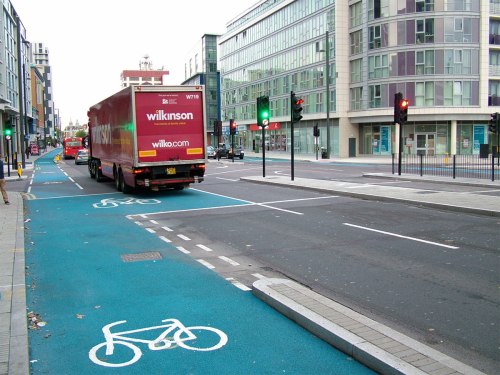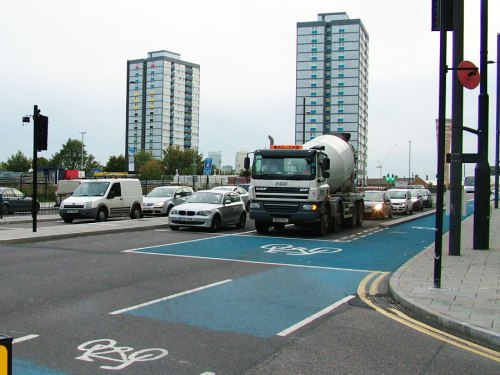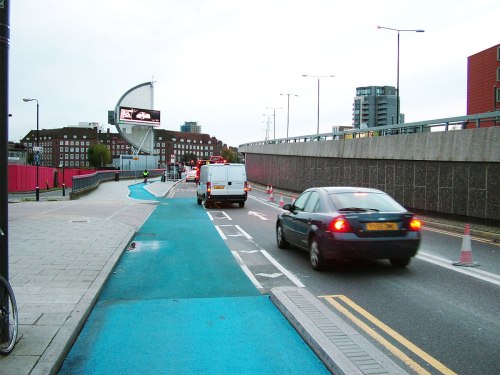This is the second in a pair of articles about the new section of Cycle Superhighway 2 from Bow roundabout to Stratford. You can read the first part here.
First, a correction
In the previous article on this subject I stated that the length of the segregated “Superhighway” was one mile, not the two miles claimed by TfL. Since then I have done some further measurements (by drawing a line on Google Maps) and found that it is in fact even shorter than that.
The new CS2 cycle track is 0.7 miles (1.1km) long on the eastbound side, and 0.8 miles (1.2km) long on the westbound side.
But as much as I bleat about it here, the damage is done. All the news sites have reported it as being two miles long, so hype has won out over substance again, and that’s the main thing for Mayor Johnson and his PR man cycling czar Andrew Gilligan. But while two miles might sound like a long way, it’s a drop in the ocean.
Let’s do some back-of-an-envelope maths. TfL controls 360 miles of road in London all of which are wide, busy and hostile to cycling. Stratford High Street is actually controlled by Newham council, but let’s be generous to TfL and pretend that it is one of theirs.
The new segregated bit of CS2 makes up 0.2% of TfL’s road network. So it’s taken five and a half years since Boris Johnson became Mayor of London to get half-baked cycle paths on just 0.2% of London’s busiest roads. Given this rate of progress, it will take 2750 years for all of TfL’s roads to get cycle paths.
I estimate that TfL-controlled roads make up roughly ⅓ of London’s ‘main’ roads, so the CS2 extension covers around 0.07% of them, and it would take over 7000 years for all of the main roads in London to become safe and inviting for cycling. I can’t wait!
Anyway, on with the show…
Sending out the wrong signals
Moving on to the next weak point, we arrive at a large signalled junction. This is the junction shown in TfL’s laughably awful instructional video on how to make right turns.
The first thing you’ll notice is that the protecting kerb stops before the junction, and the demarcation continues as painted lines, handy for left-turning drivers to keep their speed up as they cut across the bike lane. Further on, the cycle lane widens to create an ASZ in front of the nearside lane.

Mysterious bike box and speedy left-hook set up.
You can’t use it to turn right, only for going straight on or left. So what’s that ASZ for? What purpose does it hold?
You may also notice that there are no separate traffic lights for bikes. This means that left-turning drivers and straight-on cyclists get a green light at the same time. This is a recipe for disaster. It is already causing conflict.

This cement mixer is turning left. Would you want your children cycling here?

Do you trust all drivers to give way to cyclists riding straight on here?
Again, this is a very fast road with lots of traffic. Plenty of vehicles turn left here, including buses.
And again, there is pressure on drivers to keep the main carriageway clear. If the light is green then it must be uncomfortable waiting in the road to turn left, knowing that speeding vehicles are coming over the hill behind you. That’s no excuse to bully through, but it is another example of designed-in conflict.
Why haven’t TfL separated cycling from motoring in time at this junction?
TfL’s pants
On the other side of the junction we find this:

It does look a bit like a pair of pants, doesn’t it?
I call it ‘the pants junction’ because it looks like a pair of boxer shorts, albeit with a very tight crotch. It even has a fancy logo on the left leg!
This bizarre construction is part of TfL’s “innovative” loop-de-loop right turn method mentioned above. The idea is that if you want to turn right here from CS2, you instead go straight on then turn sharply left onto the pants, then ride across a shared-use footpath, where you’ll find a similar bit of tarmac:

Another one of TfL’s “innovations”
If you’re lucky enough to find the ASZ free of motor vehicles, the idea is that you can then wait at the lights to go straight on, completing your right turn.
One odd thing is that you can complete the right turn in any number of other ways. Testosterone-filled thrill-seekers can pull across into the outside lane on the main road, turning right in the traditional manner. The footpath all the way along Stratford High Street/CS2 is shared use, meaning it’s legal to cycle on the footpath. The crossings are all toucan crossings (for cycling and walking).
I get the impression that TfL didn’t really know what to do here, so they just threw everything that they could think of into the mix and crossed their fingers. There are even ‘Trixi’ mirrors, the cherry on this cake of kludges.
The pants arrangement above also enables those cycling from that side road to turn onto CS2 while the traffic lights are red, by turning sharply left across the footpath via the tarmac dropped kerb. The concept of a “turn left on red” for bikes is a good one, but the execution here is dreadful. Why do TfL continue to create new half-baked solutions to pre-solved problems?
This whole junction is a mess and should be redesigned from scratch.
Doing the Stratford wiggle
Continuing along the eastbound side, we eventually find ourselves at the end of CS2. The cycle path widens out here to a luxurious 3 metres or so, but that’s the best bit. (This is where the Mayor made sure he was photographed at the opening, of course.)
If you have eagle eyes you may notice this tiny sign:

“We will do things properly, or not at all” – Andrew Gilligan, breaker of promises.
If this junction was designed properly for cycling, signs like this would be unnecessary.
It’s strange that this sign has been put up at all really, considering that this is really the end of CS2 at present. Even if you manage to follow it you just end up in a bus lane. There’s no more blue paint beyond this point.
But the craziest thing is that it’s not actually possible to legally follow the directions on the sign anyway. There’s no dropped kerb so you can’t join the shared use footpath on the left anyway. The only dropped kerb is at the crossing itself, where people are waiting on foot. If the traffic lights are red then you can make the manoeuvre, but then you’d technically be jumping the red light. It’s a very incoherent end to CS2.

To continue along CS2, simply pull left onto the crossing where that woman is standing. “Super” eh?

Even if you follow the sign, you just end up in this contraflow bus lane anyway. Note that there’s no room for a bus to safely overtake a bike here. This is not all abilities, 8 to 80 provision.
Go West
The infrastructure westbound is pretty much the same as the eastbound side: a wide cycle path punctuated by poor quality bus stop bypasses and dangerous junctions.
But TfL have saved something special for the final stretch, just before the still-deadly Bow junction.

It must have been a Friday afternoon when they designed this bit.
There’s several things wrong here.
The first is the side-road treatment. Like the example in the previous post, the junction is dangerous. Despite there being plenty of space to take the cycle path away from the road here, it instead turns into a standard painted cycle lane. This is also the point at which the road widens to two lanes wide, so drivers aiming for the left-hand lane cut across the “Superhighway” to get to it.
This leads me to our second problem. The entry to the bus stop bypass is at an uncomfortably sharp angle, again for no good reason. The side road is one-way so there’s plenty of room to play with. Also, because the segregating kerb ends so far back, when motor traffic is queuing they can (and do) block the entry to the bus stop bypass, so people riding bikes must either wait in traffic breathing in the fumes or try to squeeze up the side of the queuing vehicles.
I shouldn’t have to do TfL’s job for them, but it should look something like this (although I missed the ~30º angled ‘forgiving’ kerbs off, they’re time-consuming to draw):

It’s really not that difficult.
In conclusion: Sigh.
This new section of CS2 is certainly a step forward from the rest of the route, which is not only extremely unpleasant but so dangerous that it has been the scene of several deaths.
And yet what has been learned from these deaths, nearly all of which have taken place at junctions? Seemingly nothing, as the junctions on the new segment of CS2 remain as deadly as those on the original section.
Kerb separated cycle tracks make for a more pleasant journey along the straight bits, but it’s the junctions which are the most dangerous, yet TfL have made no improvements there.
It’s been suggested that as this is TfL’s first ever segregated cycle track, we should be forgiving of mistakes made due to lack of experience. Sure, I’d be happy to forgive the odd small error, but this whole route is deeply flawed.
TfL’s engineers are not little kids who deserve a pat on the head for making their first Lego house. They are grown men and women, highly qualified, paid tens of thousands of pounds each year.
Sure we should praise TfL when they do stuff well, but the new CS2 is a third-rate cycling facility which is so poorly put together that it floods. What are they teaching highways engineers these days?

I can’t wait to ride here in the winter. (Photos by @sw19cam: 1, 2.)
Those responsible for this should already know what they’re doing. The learning curve should be shallow, not steep. It’s not difficult to learn about cycling infrastructure that works for everyone.
There are British highways engineers out there who do know how to do this stuff properly, why weren’t they employed to do this? Or were there genuinely skilled people working on CS2 who were hamstrung by their bosses telling them to keep it cheap and keep the cars flowing?
Can the London Cycling Campaign claim victory yet?
The LCC posted two articles about this new bit of CS2.
The first post is an honest assessment of what the authors found when they visited at the end of October. They point out many of the flaws of the new route.
The second post has a much more self-congratulatory tone, hailing this as a success of the LCC’s campaigning and protests.
But I don’t think the LCC should be patting themselves on the back, at least not very hard.
At the LCC’s 2013 AGM, a motion calling for “uniformity of provision and suitability for all ability groups” was passed by a huge majority. The purpose of this motion, as I understand it, was to finally kill off the bad-infrastructure-zombie known as the “dual network“. The flawed concept of the dual network has been hampering cycling design for far too long, and I’m glad to see another nail in its coffin.
But what this motion also does is commit LCC to push for infrastructure which is suitable for everyone – the fabled “8 to 80” cycling conditions. Allow me to paraphrase from the motion:
“The cycle network for London must be uniform, in the sense that there must be equal suitability, usability, and level of safety, of all the facilities, for all cyclists who might use them. It would be a mistake for the Superhighways or Quietways to be specified in a way that makes them less suitable, for example, for use by children, or by inexperienced cyclists.”
Surely this motion means that the LCC should only be crowing about facilities which are suitable for everyone? CS2 on Stratford High Street doesn’t meet these requirements. Not only are the junctions unsuitable for children, they’re also unsafe for confident cyclists. While I myself would always use the bus stop bypasses, flawed as they are, I witnessed several cyclists pull out onto the main carriageway to pass the bus stops, especially ones busy with waiting passengers, before pulling back in to the cycle path.
So we’ve got a facility with bits that experienced, confident cyclists avoid using, and bits that are unsuitable for those unwilling to mix with heavy traffic. Motion 5 means that the LCC shouldn’t be crowing about this as a success, but demanding that the flaws are fixed immediately.
Things can only get better
Having said all that, for all its flaws, the new CS2 is clearly an improvement on some previous attempts at cycling infrastructure:

This must have been fun to use!
Well I guess we’re definitely progressing, albeit at a glacial pace.

























 The Alternative Department for Transport is written by, and the personal opinion of,
The Alternative Department for Transport is written by, and the personal opinion of, 


